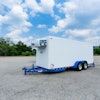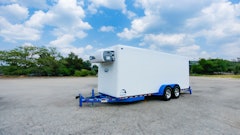Cold storage facilities with busy loading docks previously had only one of two options when it came to loading dock doors. They either went with heavy, well-insulated doors, often called hard-core doors, at the expense of employee safety and speed of operation. Or, their only other alternative was high-speed folding doors, which open and close quickly to minimize air exchange but provide little insulation against cold air escape when closed.
For most, the more popular choice had long been the former, despite their many shortcomings. These include an inability to accommodate rapid forklift traffic, slow movement when opening and closing, safety risks to employees because of their weight, drive systems that are not designed for a high number of cycles per day and poor protection from forklift damage.
Today, though, dock door manufacturers and installers are designing loading dock doors and seals that specifically meet the needs of cold storage facilities, providing models that open and close faster to prevent temperature loss and to keep forklifts moving through them at a pace that does not disrupt regular operations.
The new doors are cutting from 50 minutes per shift to 10 minutes for each dock entrance the amount of time spent by man and machine waiting for doors to open before beginning loading or unloading operations. Multiply those minutes wasted by hourly labor costs and machine operating costs and the savings can really add up.
“Advances in door technology now mean companies can come closer to having the best of both worlds. Today's doors combine fast cycling with high-efficiency insulation and effective perimeter sealing,” says Al Hochstein, product manager of Rite-Hite Doors, based in Milwaukee. “They also resist damage and have low maintenance and operating costs.”
Among the changes in door design are:
- Thicker, more flexible foam core panels that better withstand impacts and better hold temperatures;
- Faster action that opens and closes the doors more quickly;
- More effective perimeter seals on door sides and top and bottom edges;
- The elimination of wooden beams from door panels, reducing breaking, moisture absorption and corrosion;
- Better locks that ensure a tight bottom seal when closed and prevent door drift when open;
- Steel reinforced frames that provide added strength and durability;
- A smaller footprint to minimize space requirements; and
- Automatic reversing without a lot of effort or time.
These changes, for the most part, come after years of drought in terms of loading dock door innovations. Difficult door designs plagued the industry for about 15 years, according to Hochstein.
But now his company, and many others that manufacture and install loading dock doors, are taking into account the specific needs of cold storage facilities when it comes to door design.
Doors For Cold Storage
Rite-Hite, for example, offers the Barrier line of cold storage doors with 4-inch-thick fiberglass panels or 3-inch-thick Iso-Tek panels. The new doors open at speeds of between 60 inches and 84 inches per second (depending on model) and close at 30 inches per second. Panels seal tight against the walls and, due to a tubular track and hourglass roller design, better withstand impact from a moving forklift.
TKO Doors, a division of SPX Dock Products, Sussex, WI, has also come out recently with a new line of doors, called Thermalweight, designed specifically for cold storage facilities. These doors combine the energy-efficient benefits of 4-inch-thick insulation panels with greater speed of motion and more impact-resistant designs and materials.
As an added benefit, TKO is also “upgrading all our models with greater insulated panels, using a new foam that substantially reduces moisture buildup within the door panels,” according to Chris Leary, its national sales manager. And, most of the door parts are made of a tough plastic for easy cleaning.
Rytec Corp., Jackson, WI, also makes a number of cold storage doors that feature high-speed movement. Its PredaDoor opens at 50 inches per second. Its Arctec door combines the insulating qualities of a traditional cold storage door with high-speed movements of up to 7 feet per second. Its TurboSeal boasts movement of up to 100 inches per second.
Overhead doors that open at about 8 inches per second can take as long as 15 seconds to open, while most high-speed doors take about three seconds to open.
“Forklifts and material handling equipment no longer have to wait around for doors to open,” says a Rytec spokesman. “They can move from one enclosed space to another without stopping.
“Similarly, the less time that it takes for a door to open, the fewer the opportunities for dust and other airborne contaminants to enter the facility, and the lower the security risks,” he continues.
And, as an added benefit, high-speed dock doors are designed to take the rigors of literally thousands of openings and closings a day. In any given hour of the workday, a single loading dock door can go through 25 opening and closing cycles.
“As door technology advances, cold storage facilities can lessen the compromise between handling productivity and energy efficiency,” says Rite-Hite's Hochstein.
Saving Energy, Cutting Costs
They also lessen the financial burden that results when all-too-common forklift accidents compromise door seals and damage the doors themselves. The opportunities for this kind of damage are greater in food distribution, where companies often run 24-hour/seven-day operations between loading for outbound shipments and receiving on the inbound side
“The biggest problem is energy loss in gaps that form in the side and floor of doors because of forklift traffic. I'm a firm believer that this is where the primary energy loss occurs,” says TKO's Leary.
“Conventional doors have a weather strip at the opening and that's where the fork travels,” he explains. “If the forklift goes a few inches off center to the left or right, it's very easy for the seals to get damaged or dislodged from the door opening.”
When that happens, even something as small as a 1-inch gap can lead to as much as $500 a year in losses, depending on outside and inside temperatures and in which direction the building faces. That's not to mention the thousands of dollars in repair costs.
“Many facilities do not know how extreme their forklift damage is,” says Leary. “It's a common problem, and many of our customers do not even realize just how much they are spending on dock door repairs and maintenance costs.”
Some estimates place the total costs of door damage, between lost energy, lost productivity and maintenance/repair costs, at $5,500 per year per door.
TKO designs its doors with greater impact resistance through a unique knockout concept whereby door panels release from their guides when hit by a forklift or other piece of material handling equipment instead of resisting and breaking. Repair consists of a quick yank on the panel to reset the door panels back into their guides. Door gaskets are panel-mounted, enabling the door to protect its own seals better.
“These doors use spring-loaded plungers instead of conventional roller wheels,” Leary explains. “When the panels are impacted, because of the spring-loaded panel, you just simply pull them back into the tracking. You can't do that as easily with conventional doors, and that leads to energy loss, down time and repair costs.”
TKO doors are also “sectional, and the side seals are mounted to the door panel. As the doors are opened and truck loading and unloading occurs, the seals travel with the door, out of harm's way from the forklifts,” according to Leary.
Dock Doors, By Design
Door manufacturers are expanding the number of choices when it comes to door types. Loading dock doors today come as strip curtains, folding doors, roll-up doors, vertical lift doors and more. They are available with automatic and manual movement controls.
Before deciding which of these to use, Al Hochstein, product manager of Rite-Hite Doors, recommends that facilities conduct an energy analysis of their openings, taking into account:
- Inside and outside temperature differences;
- Inside and outside humidity differences;
- The number of door openings;
- Size of door openings;
- Number of hours per work day;
- Number of door cycles per hour;
- Door cycle time;
- Cost of electricity;
- Door maintenance and repair costs;
- Employee safety and comfort; and
- Material handling productivity.
The bottom line, according to Hochstein, is that when properly applied, “the results are low long-term energy costs, high handling efficiency and a safer environment for cold storage workers.”
And, having high-speed doors within a facility is a very visible statement that a company is serious about streamlining processes and keeping costs down, both important messages to send to employees, vendors, suppliers and customers alike.—L.K












